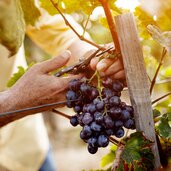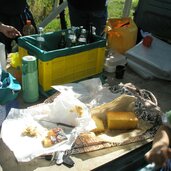Hungry harvesters have been rewarded after the vintage along the Wine Road with a simple yet tasty meal
Image gallery: About the “Plent” and the vintage
An ancient tradition in the south of South Tyrol combines the "Plent" cooking with the grape harvest. But what's behind all this? On the one hand a centuries-old custom, on the other hand practical considerations. The work in the fruit orchards and vineyards often took place far away from home. During the vintage, winegrowers and harvesters had their hands full to do so that the work couldn't be interrupted for too long around midday. The solution? The "Plentnkessel", a giant polenta kettle, was brought to the vineyard and the meal was prepared outdoors on open fire.
And what's better for hungry people than a hearty "Plent", how the polenta is called in South Tyrolean dialect: The maize from which the polenta is made, was brought from America to the Bassa Atesina area in the 16th century. For some time, the farmers cultivated it on the fields in the drained Adige wetlands known as "Möser" today. But above all in the 19th and 20th century, maize meal became one of the indispensable foods on the daily menu. It could be used in many ways and the costs for the growing of the maize (self-sufficiency) or to buy its meal were bearable.
In the middle of the 20th century, however, a new turnaround followed: The maize fields were replaced by the vineyards, which are visible today. Although already the Romans cultivated vines along the Wine Road, the vineyard area back then was significant smaller. When winegrowers and wineries united to produce high-quality wines in 1905, vineyards - and some fruit orchards in between - became dominant. Every autumn, of course, the exhausting vintage has taken place. Also the weather has played an important role - so it had to be done quickly!
Even today some farmers still celebrate this old custom. At midday, the winegrowers and harvesters enjoy a polenta - cooked in the giant kettle - together with sausages or cheese. A simply yet popular and hearty meal, which is still offered at some mountain huts. By the way, it is also allowed to eat with the fingers. This simple but efficient custom not only saves time, but supplies the body with maize meal, a glutenfree food, which is rich on carbohydrates and dietary fibres. And then... ready for the afternoon and further work in the vineyard!



































